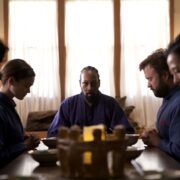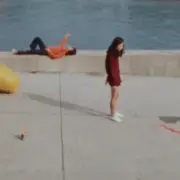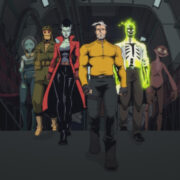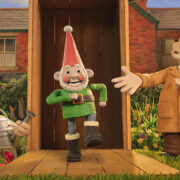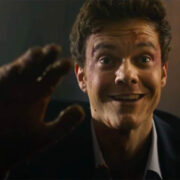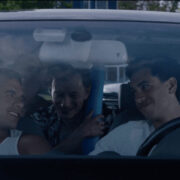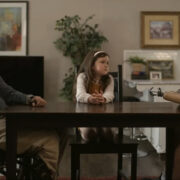What A Fright For The Whites: Fear Of The Other In SCOOBY-DOO, WHERE ARE YOU?
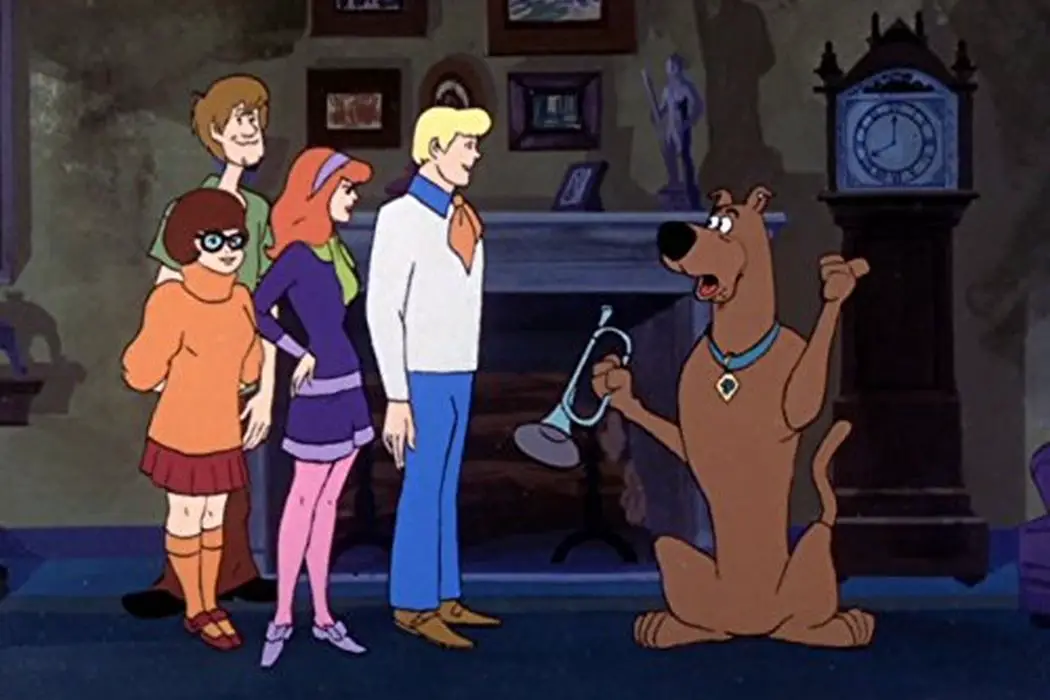
Film critic, Ithaca College and University of St Andrews graduate,…
A chorus of “Build the wall!” erupts at most Donald Trump rallies, and underneath the chants, one can hear echoes of all the xenophobic comments the President has made in public. Mostly, they’re how Mexican immigrants to the U.S. are threatening American job security, law and order, and hegemonic white power structures. Or they’re about Muslims bringing terrorism to our cities.
Beneath the hatred for the Other is fear of the Other, an anti-outsider terror that if you don’t protect what’s yours, someone else will come along and take it. Usually that someone has a different skin tone and language from you. These despicable, deeply racist sentiments are not unique to the Trump era, and this xenophobia isn’t something Trump invented. And like most things, it can be traced back to Scooby-Doo.
What A Night For A Xenophobic Fright
In the first chapter of “The Origin of Others”, Toni Morrison writes, “Since no one is born a racist and there is no fetal predisposition to sexism, one learns Othering not by lecture or instruction but by example.” Scooby-Doo of course did not set out to promote racist ideologies, but as a product of the time in which it was created, the show unfortunately advances the same xenophobia and Otherism that had always defined the American sociological structure, providing examples to generations to come of why we should fear those who are different from us.
Scooby-Doo, Where Are You?, as with the rest of the Scooby-Doo brand, predicates its grand, overarching narrative of teenage ghost-hunters on several assumptions. First, that the ghosts in the series are abnormal. Second, that they scare the gang. Third, that they scare members of the society around them (the better for keeping strangers away from sunken armored cars, etc.). And fourth, that we, the audience, understands why the characters are afraid of the ghost. It asks us to recognize that the ghost is scary, even if we aren’t personally frightened of it.
That each episode operates on these foundational givens means that even the less-scary villains like the Miner 49’er from “Mine Your Own Business” and Red Beard’s ghost from “Go Away Ghost Ship” get free passes. Whatever spirits, ghouls, or baddies the show throws our way, we believe that the gang is genuinely scared by them. Because if Shaggy and Scooby-Doo have no reason to run, neither does the show.
And yet it’s the politics behind what’s considered scary that are the most frightening. What’s more existentially threatening than that Other, than the unknown, than something so different from our own experience that its very life is a threat to ours?

Even taking a seemingly innocuous villain from the series, one can draw all sorts of conjectures about the reasons the gang finds it scary. Take the first episode, “What a Night for a Knight,” which opens with Scooby-Doo and Shaggy walking through an eerie forest by moonlight. They’re just returning home from back-to-back screenings of Star: Dog Ranger of the North (which Martin Scorsese probably wouldn’t think is cinema). That’s when they chance upon a derelict truck. Inside is a black suit of armor. This alone is enough to frighten them. And when the black knight — or, “tall, tin, dark, and creepy,” as Velma calls him — becomes animated and chases them down, they’re even more horror-struck by the guy.
While they fear the knight — or, sorry, the ghost of the black knight — what the gang really fears is antiquity. They’ve encountered the personification of a bygone era from an ostensibly foreign land; the characters say “London, England” like it’s the most obscure, faraway place on Earth.
Scooby-Doo Meets John Wayne
In “Hassle in the Castle,” a few episodes later, the gang again negotiates historicality butting heads with modernity. They run aground on Haunted Isle — literally the island’s real name — and enter the “old Vasquez Castle,” a phrase they will continue to say two or three more times to emphasize that it is old, it’s a castle, and it belonged to a Spanish pirate. As Shaggy opts, “What a pad for a scare in.” I love the way people talk in this ridiculous show.
This is the episode where the ghost looks like a man in a sheet but can actually float through walls (it turns out to be controlled by a notorious illusionist). Naturally, the plot culminates with a convoluted trap into which Fred needs Scooby-Doo to lure the ghost. But most fascinating is that Scooby doesn’t just show up and catch the ghost’s attention, which is how this usually plays out. “Just think of John Wayne,” Fred encourages him before dispatching Scooby to deal with their ghost.
So it follows that Scooby engages in a Western standoff with the spirit, clad in a tan rain coat and fedora (that admittedly seems more Humphrey Bogart than John Wayne, but what 8-year-old will understand a Bogart reference?). Scooby puts his paws on his hips and paces heroically down the hall, and the ghost adopts the same walk toward Scooby.
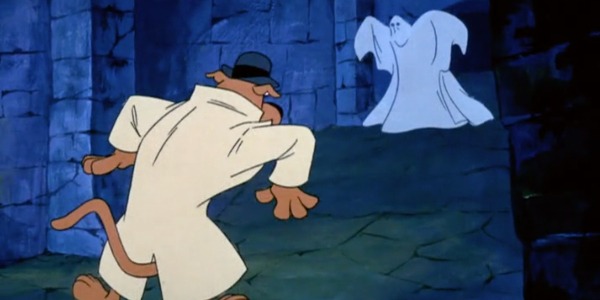
This is the perfect tableau of the show’s quintessentially American attitudes: The embodiment of new American exceptionalism and celebrity heroism, very much a 20th-century Western ideal, squares off against a phantasmagoric remnant of pre-frontier days. This conflict resurfaces over and over again throughout the series and throughout every installment in the ongoing Scooby-Doo canon.
Every fresh reprisal of this conflict comes with its own signifiers. In “Go Away Ghost Ship,” pirates resemble lawlessness on the high seas that should have been corrected by American military and cultural dominance. “Scooby’s Night with a Frozen Fright” finds the gang contending with a caveman. “Haunted House Hang-up,” pits the gang against a headless specter dressed like a 1700s colonial nobleman. Only rarely does Mystery, Inc. come up against a phantasm from the future — the alien in “Spooky Space Kook” and the android in “Foul Play in Funland” are the series’ only examples — but when they do, they run from them as well.
All their villains incarnate locales, beliefs, and peoples external to the gang’s myopic worldview. That is, young and hot and living in American suburbia in the late ’60s or early ’70s. That ecological perspective triggers the alarum of the Miner 49’er — nothing is scarier to a blue-collar suburbanite than the ghost of a rural midwestern coal miner.
Nothing But Everything To Fear
In the 25 episodes of the original run of Scooby-Doo, Where Are You?, the show’s villains embody a rotating door of fears of a rotating door of Others. “Mine Your Own Business” has the fear of the Old West, ghost towns, coal mines, and old people. “Never Ape an Ape Man?” The fear of gorillas, which is really the fear of African culture and wildlife. “Foul Play in Funland”? The fear of artificial intelligence and that one day, automation will erase all jobs in the private sector.
“Foul Play in Funland” also boasts one of the best lines in the series, when Velma is stuck in a rogue dodgem cart with Scooby and can’t see where she’s driving. “There’s no brakes, Scooby, and I can’t see without my glasses, but it’s a nice wide street,” she says as she barrels through tables and food stands. It’s also got one of the most sinister scenes, when the robot, Charlie, chases Scooby into a wax museum. Scooby poses as a caveman beside a prop wolf in the prehistoric exhibit, and thinking the wolf is Scooby, Charlie grabs it by the neck and shakes it so violently that the wolf’s limbs fall off.
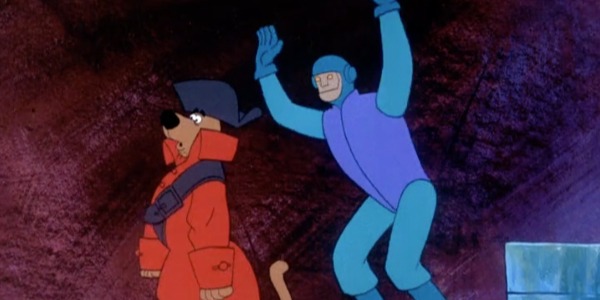
The scene perhaps postulates that the robot’s innate status as an artificially intelligent man makes him an abomination separate to all of human society, whose very existence is threatened by Charlie’s. This is the classic Otherism narrative — using the example of Charlie to spark animosity toward change and the future. No matter that the story resolves with Charlie being domesticated and petting Scooby-Doo; it comes on the heels of 20 minutes of the gang fearing Charlie and being chased by him.
The ending also oddly assuages the undercurrent throughout the episode concerning the job market at the titular Funland. The automation running the park is tied directly to Charlie the Robot — he is the avatar of scientific progress and robotization in the workforce. One of the fears powering the episode is basically “Charlie’s not only scary, but he’s also here to take our jobs” — one of the primary engines of American xenophobia.
Scooby-Doo And The Indigenous, Too
While nominally, ghosts, ghouls, and things that go bump in the night are the chief threats facing Scooby and the gang, their biggest enemy, it seems, is diversity. The show is rife with microaggressions and instances where mockeries are made of other cultures. The “Hassle in the Castle” episode features a gag where Fred and Daphne sit on the illusionist’s magic carpet and Fred says, “Ali go oop,” and the magic carpet is off. A classic example of mystifying the Oriental and then shitting all over it.
In “What the Hex Is Going On?,” the gang seeks the help of a swami — basically a monastic Hindu yogi. The swami, a figure of respect and wisdom in Hinduism, is ferociously parodied in Scooby-Doo. The swami isn’t home, but a client enters. To ward off suspicion, Scooby throws on a towel and a turban with a jewel in the top while Shaggy throws his voice. “What do you see in the crystal ball?” the wealthy woman asks Swami-Doo.
Scooby mystically rubs the ball. “My reflection,” replies Shaggy. Big zoinks.
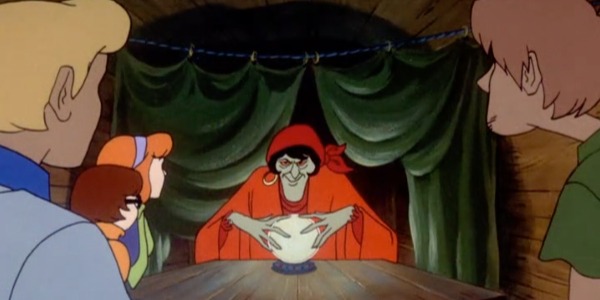
The swami concept later returns as a gypsy — double zoinks — in “A Gaggle of Galloping Ghosts.” Curiously, the gypsy’s get-up and parlor don’t differ too much from those of the swami. I guess all non-Western mystics are the same.
These are just three instances of parodying nonwhite cultures, and all three occur in episodes whose ghosts are firmly rooted in Anglo-Saxon tradition. These are all episodes from the first two seasons, too — I should note that Scooby-Doo, Where Are You? aired a third season in 1978, eight years after the second. That third season features an episode set in Turkey, one set in Puerto Rico, one featuring Inuits, and another titled “Scooby’s Chinese Fortune Kooky Caper.” Surely, this spells big zoinks aplenty.
But if those were all examples of racism deployed for comedy, how does the show transform the Other from a racial pariah into a monster hellbent on scaring the living daylights out of middle- to upper-class white children?
Sticking to the original two seasons, “Decoy for a Dognapper” is among the most problematic in this camp. It capitalizes on the fear of Native Americans, expecting the audience to make a connection to tales of scalpings and anti-white aggression. “Nobody’s getting my beautiful hair!” Shaggy cries out at one point.
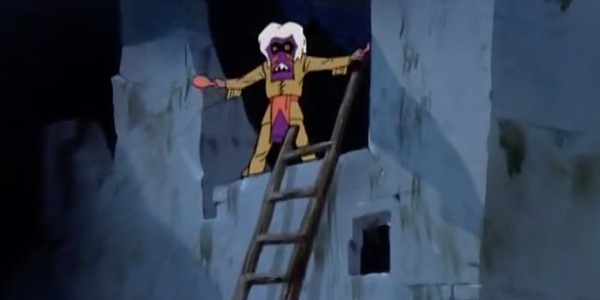
When Scooby-Doo is dognapped, his captors take him to an old Pueblo cliff dwelling. Shaggy in pursuit encounters a ghost Indian — who gets his own Native American music cue that made me very uncomfortable — “Man, it’s Geronimo!” Shaggy yells. Later, he puts the cherry on top: “With this weirdo Indian attack, I felt like a late-show rerun of Custer’s Last Stand!” It’s all very indigenous-phobic. Fred even pronounces it “injun” like John Wayne.
Who’s Afraid Of The Big Bad Peter Lorre?
Paramount to most xenophobic narratives is the rending of the Other as a foreign species, to insist that one is normal. Toni Morrison writes about this phenomenon in “The Origin of Others” regarding slaves and slave owners: “Even assuming exaggeration by the slaves, the sensibility of slave owners is gothic. It’s as though they are shouting, ‘I am not a beast! I’m not a beast! I torture the helpless to prove I am not weak.’ The danger of sympathizing with the stranger is the possibility of becoming a stranger. To lose one’s radical-ized rank is to lose one’s own valued and enshrined difference.”
So in the two episodes focused on Asian mythology, “That’s Snow Ghost” and “Mystery Mask Mix-Up,” the show not only renders the ghosts as foreigners to be feared, but the people as well. “That’s Snow Ghost” has a bizarre Peter Lorre lookalike, for instance. Though the character, Mr. Leech, is likely a tribute to Lorre’s storied work in horror cinema from M to his late-career stint with Roger Corman, the Hungarian actor’s performances as the Japanese detective Mr. Moto cast an uncomfortable shadow over “That’s Snow Ghost.” To boot, Shaggy and Scooby are spooked by Mr. Leech, the sign that it’s alright to read a foreigner as scary. Mr. Leech doesn’t even wind up being the villain!
The episode then doubles down on the racism as the gang investigates a cavern in the snow. They’re met with a roomy abode filled with Buddhist artifacts — a gong, a Buddha statue. And the Tibetan monk who owns the place emerges from the back of the cave, saying, “Who dares enter the temple of Fu Lan Chi?”
Though there’s an in-episode reason why Fu Lan is staying in a cave, in flashback, we see him traversing the treacherous snowy mountains of his home country when he comes into contact with the Yeti. The disconcerting implication is that all Tibetans, if not all Asians or all Buddhists in general, are unsophisticated cave-dwellers with primitive beliefs in ghosts and who are locked in perpetual battle with Yetis on wintry mountaintops. Or they’re creeps like Mr. Leech.

The biggest “zoinks” moment arrives with “Mystery Mask Mix-up.” The story already stokes Yellow Peril fears by pitting the gang against the Scare Pair and the Ghost of Zen Tuo — all stereotypically Chinese demons — and then having the ghosts kidnap Daphne. But then the episode turns a corner.
The Scare Pair is chasing Shaggy and Scooby when man and dog run behind a door. When it opens, they’re costumed as Chinese waiters — caps, buck teeth, and all — and they seat them at a table as a diversion. “You two wook wike you could use a wittle fattening up!” Shaggy says. Full-body shiver city.
Scooby-Doo And The Cancellation Station
So is Scooby-Doo, Where Are You? a racist show?
Whether or not Scooby-Doo’s maiden voyage as a series promotes racist messaging has been pretty clearly delineated — it uses xenophobic thinking to power a praxis of politics for propelling the narrative. The issue then falls to how easily absorbed those messages are. I’m not one to announce the cancellation of programming based on racist intentions or effects. I continue to watch the show every couple of Halloweens, and that practice won’t end because the show veers into uncomfortable xenophobic territory at times. One must balance nostalgia with awareness of the time in which the media was built.
There are moments in which the show acknowledges its Otherism; “Foul Play in Funland” ends, after all, with the robot converted to benevolence. The villain in “A Gaggle of Galloping Ghouls” is outed after it’s discovered he’s appropriating the image of the gypsy for his own ill-gotten gains. “That’s Snow Ghost” ends with the man behind the mask not being Mr. Leech or Fu Lan Chi, but rather a white man using the myth to scare off guests.
The show frequently finds wealthy white men using native folktales and superstitions to frighten people. The rich white dognapper, disguised as a Native American witch doctor, shouts from a Pueblo house, “Leave this place, pale-faced intruders. Or suffer fate of Spanish conquistadores buried in desert below! Remember my warning and go!” “A Tiki Scare Is No Fair” likewise packs on one stereotype after another with its Witch Doctor ghost before unmasking him — it was a white professor the whole time!
These denouements never go far enough, but the intent is there to examine the Otherism at the heart of the show. These are men who appropriate the cultures and superstitions of minority groups to frighten white people away — using our society’s xenophobia to their advantage. In its most extreme cases, the show might actually encourage empathy with these minority groups. At the end of “Scooby-Doo and a Mummy, Too,” it’s hard to fathom that any viewer would walk away from the episode with an antipathy or fear of Egyptian culture. Often, the sense I get at the resolution of a Scooby-Doo episode is that the show has very little genuine animosity toward minority groups. (There’s still some there — it was Hanna Barbera in the ’60s, after all.)
So the Yeti is a white man, and so are the Witch Doctors. The indigenous culture, too, became a disguise. White men wear the clothing of the Other to stoke racism. Perhaps there’s power in stripping xenophobia down to a sad, defeated, spineless white man in a mask. Trying, trying to still make us hate, still make us fear.
What do you think about Scooby-Doo and Otherism? Is the show racist? Let me know in the comments below.
Does content like this matter to you?
Become a Member and support film journalism. Unlock access to all of Film Inquiry`s great articles. Join a community of like-minded readers who are passionate about cinema - get access to our private members Network, give back to independent filmmakers, and more.
Film critic, Ithaca College and University of St Andrews graduate, head of the "Paddington 2" fan club.


